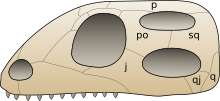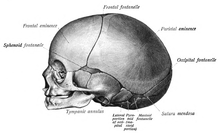


Temporal fenestrae are openings in the temporal region of the skull of some amniotes, behind the orbit (eye socket). These openings have historically been used to track the evolution and affinities of reptiles. Temporal fenestrae are commonly (although not universally) seen in the fossilized skulls of dinosaurs and other sauropsids (the total group of reptiles, including birds).[1] The major reptile group Diapsida, for example, is defined by the presence of two temporal fenestrae on each side of the skull. The infratemporal fenestra, also called the lateral temporal fenestraorlower temporal fenestra, is the lower of the two and is exposed primarily in lateral (side) view.

The supratemporal fenestra, also called the upper temporal fenestra, is positioned above the other fenestra and is exposed primarily in dorsal (top) view. In some reptiles, particularly dinosaurs, the parts of the skull roof lying between the supratemporal fenestrae are thinned out by excavations from the adjacent fenestrae. These extended margins of thinned bone are called supratemporal fossae.

Synapsids, including mammals, have one temporal fenestra, which is ventrally bordered by a zygomatic arch composed of the jugal and squamosal bones. This single temporal fenestra is homologous to the infratemporal fenestra, as displayed most clearly by early synapsids.[2] In later synapsids, the cynodonts, the orbit fused with the fenestral opening after the latter had started expanding within the therapsids. Most mammals have this merged configuration. Later, primates re-evolved an orbit separated from the temporal fossa. This separation was achieved by the evolution of a postorbital bar, with haplorhines (dry-nosed primates) later evolving a postorbital septum.[3]
Physiological speculation associates temporal fenestrae with a rise in metabolic rates and an increase in jaw musculature. The earlier amniotes of the Carboniferous did not have temporal fenestrae, but two more advanced lines did: the synapsids (stem-mammals and mammals) and the diapsids (most reptiles and later birds).
There are four types of amniote skull, classified by the number and location of their temporal fenestrae. Though historically important for understanding amniote evolution, some of these configurations have little relevance to modern phylogenetic taxonomy. The four types are: